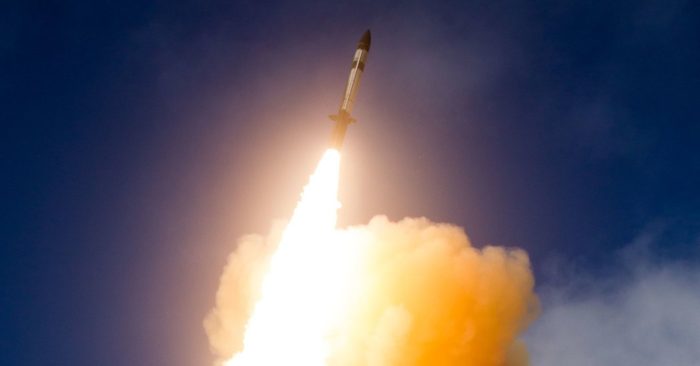


WASHINGTON — An American interceptor missile missed its target in a test off the Hawaiian coast on Wednesday, Defense Department officials said, renewing concerns of how the United States will defend itself in the event of a missile attack by North Korea or another adversary.
A Pentagon official said that the interceptor, an SM-3 Block IIA missile that is being developed by the Raytheon Company, was launched from a test site in Hawaii. Officials likened the test launch to an attempt to hit a bullet with another bullet.
It was the second failure over the past year of a test of the SM-3, known as the standard missile; the last one was in June.
Mark Wright, a spokesman for the Missile Defense Agency, confirmed “a live-fire missile flight test” from Kauai. He did not confirm that the test had failed.
But two Defense Department officials, speaking on grounds of anonymity because they were not authorized to publicly discuss the test’s failure, said that the missile missed hitting the incoming dummy missile.
The failure comes as tensions with North Korea are running high. But it was somewhat routine for a missile defense system that even advocates will not promote as providing a defensive shield. Around half of the tests over the 13 years since the system became operational have been declared fully or partly successful.
Last August, the United States did successfully intercept a medium-range ballistic missile off the coast of Hawaii.
North Korea fired an intercontinental ballistic missile in November that flew both higher and longer than previous launches. Analysts said that missile had exhibited a potential range of more than 8,000 miles, able to reach Washington or any other part of the continental United States.
Pyongyang has worked hard to be able to overwhelm defense systems that the Pentagon has placed in California, Alaska and Hawaii. North Korea regularly practices firing salvos of missiles because the American system is designed to intercept only one or two incoming warheads at a time.
Analyses of recent North Korean flight tests and missiles that have been paraded through the streets of Pyongyang suggest that the North may also be seeking to develop maneuverable warheads. Such a tactic, if successfully developed, would help warheads dodge antimissile interceptors.
Tests of the United States’ multibillion-dollar efforts at missile defense have had mixed results. A Pentagon report last year criticized the long-range system, saying that it “demonstrates a limited capability to defend the U.S. homeland from small numbers” of medium- and long-range missiles “launched from North Korea or Iran.”
Military officials said that it was unclear why Wednesday’s test failed.
On Tuesday, President Trump used his State of the Union speech to lash out at the North Korean government. He said that the country’s leader, Kim Jong-un, had brutalized his own people, and that he must be made to relinquish his nuclear program.
more recommended stories
 Fentanyl Seizures at Border Continue to Spike, Making San Diego a National Epicenter for Fentanyl Trafficking
Fentanyl Seizures at Border Continue to Spike, Making San Diego a National Epicenter for Fentanyl TraffickingFentanyl Seizures at Border Continue to.
 Utah Man Sentenced for Hate Crime Attack of Three Men
Utah Man Sentenced for Hate Crime Attack of Three MenTuesday, August 8, 2023 A.
 Green Energy Company Biden Hosted At White House Files For Bankruptcy
Green Energy Company Biden Hosted At White House Files For BankruptcyAug 7 (Reuters) – Electric-vehicle parts.
 Former ABC News Reporter Who “Debunked” Pizzagate Pleads Guilty of Possessing Child pδrn
Former ABC News Reporter Who “Debunked” Pizzagate Pleads Guilty of Possessing Child pδrnFriday, July 21, 2023 A former.
 Six Harvard Medical School and an Arkansas mortuary Charged With Trafficking In Stolen Human Remains
Six Harvard Medical School and an Arkansas mortuary Charged With Trafficking In Stolen Human RemainsSCRANTON – The United States.
 Over 300 People Facing Federal Charges For Crimes Committed During Nationwide Demonstrations
Over 300 People Facing Federal Charges For Crimes Committed During Nationwide DemonstrationsThe Department of Justice announced that.
